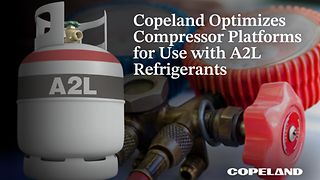Posted by Janet B. Stroud — September 14, 2023 — Copeland, a global provider of sustainable climate solutions, announced it is optimizing its major Copeland air-conditioning (AC) and refrigeration compressor platforms for reliable use with A2L refrigerants while improving performance.
John Schneider, president, HVACR Americas at Copeland, stated:
As a global technology leader in heating, air conditioning, and refrigeration, Copeland has been helping customers achieve their sustainability, decarbonization and regulatory compliance goals. This next generation of safe, reliable and highly efficient A2L compressor technologies is designed to help industry stakeholders transition to lower global warming potential (GWP) refrigerants and meet sustainability goals and environmental regulations in a timely and competitive manner.
To prepare for the imminent approval and wider adoption of A2L refrigerants, Copeland’s portfolio of next generation A2L-optimized compression technologies includes the following recently listed refrigerants:
- R-32 (675 GWP) and R-454B (466 GWP) for air-conditioning applications; and
- R-455A (146 GWP), R-454C (148 GWP) and R-454A (238 GWP) for refrigeration applications
Copeland has also qualified rotalock service fittings and electronic componentry for use with A2Ls, including onboard compressor protection, variable frequency drives (VFDs), contactors and sealed relays.
On May 24, the U.S. Environmental Protection Agency (EPA) — under its Significant New Alternatives Policy (SNAP) Program — proposed SNAP Rule 26, which includes new listings and use conditions for flammable refrigerants used in commercial and industrial refrigeration. The proposed SNAP Rule 26 is part of a multifaceted effort by the EPA to phase down the supply and demand of high-GWP hydrofluorocarbon (HFC) refrigerants.
In 2020, the passing of the American Innovation & Manufacturing Act (AIM Act) authorized the EPA to mandate HFC supply restrictions and establish sector-based GWP limits. To facilitate a transition to lower GWP refrigerants, the EPA continues to approve additional refrigerants through the SNAP program. For air-conditioning applications, the SNAP 23 and 25 Rules list several mildly flammable (A2L) refrigerants, including R-454B and R-32, as acceptable, subject to use conditions in new residential and light commercial air conditioners and heat pumps.
Schneider added:
For industry stakeholders, the SNAP 26 proposal is an indication that the EPA is likely to move towards approving A2L refrigerants in refrigeration and industrial applications where applicable safety standards — developed by the Underwriters Laboratory (UL) and the ASHRAE — are now in place to govern the safe use of A2Ls in these applications.
A2L refrigerants can be used as viable alternatives to current A1 refrigerants in new systems, which is why they are being adopted in air conditioning and commercial refrigeration applications.
A2Ls also have a likely place in distributed refrigeration architectures, such as remote, outdoor condensing units or mini racks used in smaller-format outlets. Composed of various blends of HFO refrigerants and select lower GWP HFCs, A2L refrigerants are among the few alternatives available to deliver expected GWP reductions below the 700 GWP regulatory thresholds in air conditioning applications, and 300 and 150 GWP thresholds in commercial refrigeration applications.
Combined with refrigerant leak detectors and supervisory control architectures, Copeland’s full A2L component portfolio reflects its commitment to maximizing A2L application safety and refrigeration reliability.
Copeland has invested in its global laboratory and manufacturing facilities to accommodate its A2L product development, with the following domestic capabilities:
- 42 A2L performance test rooms
- 240 A2L life testing stands
- State of the art power electronics lab capable of testing A2L refrigerants
- Psychrometric and environmental chambers capable of testing systems with A2L refrigerants
- $12 million in additional A2L testing capabilities in its manufacturing facilities.
- Technician and manufacturing expertise to meet customer requirements.
Schneider concluded:
By leveraging its domestic manufacturing footprint, Copeland is committing to lower A2L product lead times to meet the changing demands of the industry.
Production for air-conditioning A2L models began in 2022; further models are following with a staggered release based on OEM requirements. Production for refrigeration A2L models began this summer, and further model releases will be staggered across all major product platforms.
To learn more about how Copeland is helping the HVACR industry transition to lower GWP refrigerants, visit the company’s HVACR regulatory information webpage. To explore more A2L-related content from Copeland, visit the A2L refrigerant information webpage. Learn more about Copeland’s sustainable solutions at Copeland.





